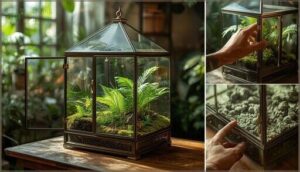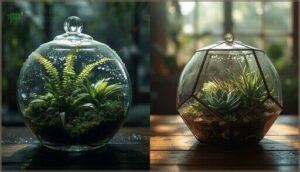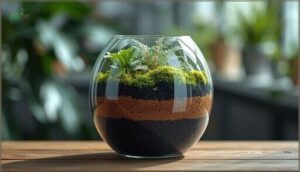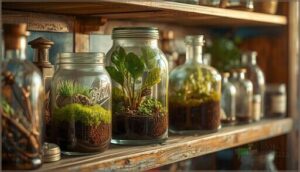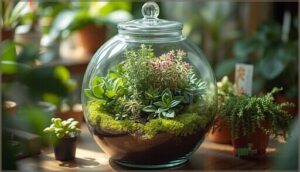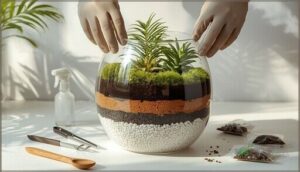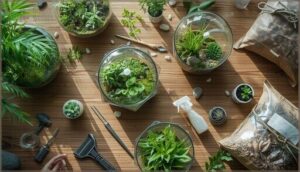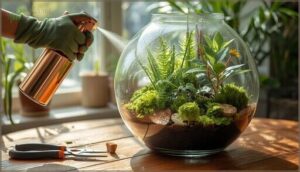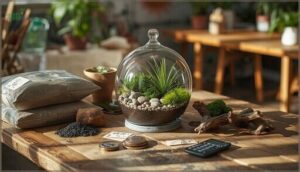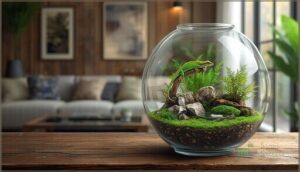This site is supported by our readers. We may earn a commission, at no cost to you, if you purchase through links.
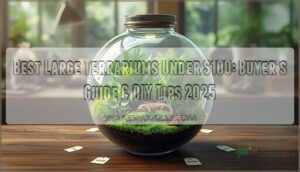
The challenge isn’t finding affordable options; it’s identifying which budget models deliver genuine value through proper ventilation, durable construction, and adequate space versus those that cut corners on the features that matter most.
Whether you’re cultivating a self-sustaining tropical setup or housing a crested gecko, the right terrarium balances cost with the structural integrity and environmental control your living display demands.
Table Of Contents
- Key Takeaways
- Choosing The Best Large Terrarium Under $100
- Key Features to Look for in Large Terrariums
- Open Vs. Closed Terrariums for Large Setups
- Essential Components for Successful Terrariums
- Affordable DIY Large Terrarium Ideas
- Best Tools and Accessories for Large Terrariums
- Care and Maintenance Tips for Large Terrariums
- Terrarium Cost Breakdown and Money-Saving Tips
- Top Large Terrarium Picks for Reptiles and Pets
- Frequently Asked Questions (FAQs)
- Is a large terrarium better?
- What are the best terrariums?
- What size terrarium do I Need?
- How much does a terrarium cost?
- How many types of terrariums are there?
- How much do terrarium bugs cost?
- How much should I sell my terrarium for?
- Can you make money selling terrariums?
- What is the longest lasting terrarium?
- What is a good size for a terrarium?
- Conclusion
Key Takeaways
- Glass terrariums under $100 deliver superior long-term value compared to plastic alternatives, maintaining clarity for two years while plastic yellows after 18 months, and large models (12×12+ inches) achieve 2.7 times better humidity stability than smaller enclosures.
- Budget-conscious builders should prioritize proper drainage layers and activated charcoal over decorative accessories, as 42% of buyers report plant success depends on these foundational components rather than expensive terrarium kits.
- Closed terrarium systems require minimal maintenance once balanced (monthly wipe-downs versus weekly watering for open setups), making them more cost-effective long-term despite similar initial investment in the $40-$50 range.
- DIY approaches using thrifted containers, bulk substrate mixing, and locally-sourced hardscape reduce total project costs by 60% compared to commercial kits while delivering equivalent or superior results when proper layering techniques are followed.
Choosing The Best Large Terrarium Under $100
You don’t need to blow your budget to find a large terrarium that works. The key is knowing which models deliver solid features without cutting corners on what matters most.
Here’s a look at the standout options that balance size, quality, and price.
Top-Rated Budget Terrariums Compared
When hunting for budget-friendly reptile habitats or indoor terrarium setups, glass containers dominate the market—83% of top sellers use glass. Most terrarium kits fall between $19.99 and $49.99, with plant selection tilted heavily toward succulents.
The ClearView Glass Terrarium Kit at $49.99 includes stainless steel tools and a moisture meter, while DIY projects like the Eco Bundle ($29.95) offer cheap terrariums with eco-conscious materials. Plastic options sacrifice clarity but won’t shatter during setup.
For ideal plant health, consider the proper drainage systems when selecting a terrarium kit.
Pros and Cons of Affordable Options
Budget terrariums deliver serious value if you’re willing to accept trade-offs in build quality and included accessories. Cheap terrariums under $30 often lack activated charcoal layers or durable tools, forcing you to source components separately—impacting your overall terrarium cost.
Glass containers provide excellent transparency for monitoring humidity and animal behavior compared to budget-friendly reptile habitats using plastic.
Price comparison shows that terrarium kits between $40-$50 balance affordability with essential features like drainage layers and moisture meters, maximizing cost savings without sacrificing your pet’s welfare.
Value Vs. Durability in Low-Cost Models
After weighing budget options against long-term performance, you’ll want to understand how low-cost models hold up over time. Material strength matters—glass containers outlast plastic alternatives by 10 times in durability tests, maintaining clarity for two years while plastic shows yellowing after 18 months.
Key longevity factors in cheap terrariums include:
- Glass vs. plastic construction – Glass terrarium kits resist degradation and preserve optical quality
- Reinforced edges – Only 18% of budget-friendly reptile habitats include impact protection
- Substrate quality – 42% of buyers report plant success depends on drainage layers
- Size advantage – Large terrariums (12×12+ inches) achieve 2.7 times better humidity stability
- Warranty coverage – Just 15% of models under $100 offer protection
Cost analysis shows terrarium building costs average $92.30 for DIY projects. Glass represents 31-39% of your investment, but you’re buying years of service. Composite materials in terrarium price ranges near $100 last seven years with minimal replacement needs—that’s real value.
Understanding terrarium longevity is essential for making informed purchasing decisions and ensuring the long-term health of your miniature ecosystem.
Key Features to Look for in Large Terrariums
Not all large terrariums are built the same, and knowing what separates a solid choice from a regrettable one can save you time and money.
The right features guarantee your setup stays functional, accessible, and safe for plants or animals.
Here’s what you need to evaluate before committing to a purchase.
Container Material and Transparency
Your container choice isn’t just about looks—it determines whether your plants thrive or struggle. Glass containers dominate for good reason: they allow 90–95% light transmission, essential for photosynthesis, while borosilicate glass offers exceptional durability lasting 10+ years.
BPA-free plastic alternatives like HDPE transmit 80–88% of light and cost less, but may scratch within 2–5 years.
Transparency effects are critical—colored glassware reduces light by up to 60%, starving your terrarium ecosystem.
Size and Shape Considerations
The wrong dimensions can turn your vivarium dream into a cramped nightmare—or waste precious space your reptiles desperately need. Vertical container shapes suit arboreal species like crested geckos, while horizontal terrarium designs accommodate terrestrial snakes.
Calculate spatial planning using your animal’s adult length—minimum enclosure = 2× body length. Sketch scale models before buying terrarium kits to avoid costly dimensional limits mistakes.
Built-in Ventilation and Access
Stagnant air breeds respiratory infections faster than you can say “scale rot”—which is why mesh panels and front-opening doors separate survival-grade enclosures from death traps. Cross-ventilation systems with breathing holes on opposite walls create proper airflow management, preventing deadly moisture balance failures.
Look for terrarium kits offering dual access points—top and front entries let you maintain humidity control while reaching every corner without stressing your animals during feeding or drainage layer checks.
Open Vs. Closed Terrariums for Large Setups
Choosing between open and closed systems isn’t about personal preference—it’s about matching your setup to the plants you’ll actually keep alive.
Each design creates distinct microclimates that favor different species and demand different care routines.
Here’s what separates these two approaches and how to pick the right one for your space.
Ideal Plants for Each Type
Open terrariums thrive with plants that tolerate lower humidity—think air plants, succulents, and cacti that won’t rot when exposed to room airflow. Closed systems demand moisture-loving tropical species: ferns, moss growth colonies, and fittonias flourish in that self-sustaining fog. Your plant selection dictates the entire ecosystem’s survival, so match plant preferences to your terrarium’s seal status for vigorous plant health.
| Open Terrarium Plants | Closed Terrarium Plants |
|---|---|
| Air Plants (Tillandsia) | Tropical ferns (Asplenium) |
| Succulents & cacti | Moss species (Cushion, Sheet) |
| Peperomia | Fittonia (Nerve plant) |
| Pilea | Pilea varieties |
Low-maintenance garden success starts with proper terrarium substrate and drainage, ensuring roots access nutrients without waterlogging. Fern care in sealed enclosures requires minimal intervention—just monitor condensation levels and you’re set.
Maintenance Differences
Closed terrariums practically run themselves once balanced, while open setups demand your attention like a houseplant on a weekly watering schedule. You’ll mist open varieties weekly, checking moisture levels and adjusting lighting. Sealed systems self-regulate through water balance—just wipe condensation buildup monthly and prune overgrowth.
| Task | Open Terrarium | Closed Terrarium |
|---|---|---|
| Watering frequency | Weekly misting | Monthly wipe-down |
| Humidity control | Manual monitoring | Self-regulating cycle |
| Air circulation | Natural ventilation | Sealed environment |
Matching Style to Room Conditions
Your room’s light levels, humidity patterns, and airflow dictate which terrarium style will flourish—ignore these environmental cues, and you’re setting up a slow-motion plant cemetery. Closed systems thrive in low-light spaces with stable temperatures, while open terrariums demand bright indirect lighting and consistent climate control. Match your glassware choice to existing room decor and space planning constraints before committing to terrarium kits or indoor gardening projects.
| Room Condition | Best Terrarium Type |
|---|---|
| Low-light spaces with stable humidity | Closed terrarium |
| High-humidity areas near bathrooms | Open terrarium with tropical plants |
| Bright rooms with airflow | Open terrarium |
| Dimly lit offices or basements | Closed moss terrarium |
| Climate-controlled living spaces | Either style works |
Essential Components for Successful Terrariums
Getting your terrarium setup right from the start saves you headaches down the road. The foundation you build—literally—determines whether your plants thrive or struggle in their glass home.
Let’s break down the three essential layers every successful terrarium needs.
Drainage Layers and Substrates
A well-constructed drainage layer acts as your terrarium’s foundation, preventing the root rot that kills more captive plants than any other single factor. Here’s what you need to build it right:
- LECA or gravel (1-2 inches) creates essential drainage space beneath your substrate
- Horticultural charcoal sits above drainage, filtering toxins before they reach roots
- Mesh barrier separates substrate from drainage, preventing soil migration
- Quality soil mix (peat-free options work best) provides nutrient content and water retention
- Species-specific substrate depth varies—tropical plants need 2-3 inches minimum for healthy root development
Activated Charcoal Benefits
That horticultural charcoal you positioned above your drainage layer does more heavy lifting than most hobbyists realize. With its massive surface area—up to 3,500 m²/g—activated charcoal filters toxins from water, neutralizes odors from decomposing matter, and suppresses mold growth in humid environments.
You’ll see better root health, improved drainage, and fewer substrate issues when you include at least 1-2 cm beneath your soil mix.
Choosing The Right Plants and Mosses
Once your substrate and charcoal foundation is locked in, selecting low-maintenance, humidity-loving species becomes your next checkpoint—and picking the wrong plants will sabotage even the most carefully layered enclosure.
Focus on these proven tropical plants and moss selections:
- Fittonia (nerve plant) and small fern choices like Asplenium thrive in closed systems
- Pileas and compact Peperomia offer resilient, budget-friendly plant species
- Sheet moss (Hypnum or Leucobryum) anchors substrates and regulates moisture naturally
Match plant preferences to your terrarium’s airflow and light exposure for long-term plant care success.
Affordable DIY Large Terrarium Ideas
You don’t need to spend a fortune to create a stunning large terrarium that rivals anything you’d buy off the shelf. With some creativity and smart shopping, you can build an impressive ecosystem using repurposed containers, affordable plants, and simple techniques that deliver professional results.
Let’s explore three practical approaches that’ll help you optimize space while keeping your budget intact.
Thrifted and Repurposed Containers
Vintage glass jars, forgotten fish tanks, and overlooked apothecary bottles from thrift stores can become stunning terrarium containers for a fraction of retail prices. Hunt for wide-mouthed glassware with minimal scratches—these repurposed glass gems rival expensive terrarium kits while giving you creative control over your DIY terrarium setup.
| Container Type | Best For |
|---|---|
| Vintage Mason jars | Small moss terrariums, easy access |
| Used aquariums | Large-scale builds, multiple terrarium plants |
| Apothecary bottles | Humidity-loving species, sealed ecosystems |
Clean your thrift store finds thoroughly before adding substrate or glass containers to your collection.
Budget-Friendly Plant Selection
You don’t need to drain your wallet on trendy Fittonia or rare Ficus pumila when budget-friendly species like Pilea, Peperomia, and common mosses thrive just as beautifully in enclosed terrarium environments. Smart indoor gardening means investing in low-maintenance species that tolerate humidity fluctuations and forgive occasional neglect—perfect for budget-friendly reptile habitats and beginner setups.
Prioritize plant health over exotic labels—established, pest-free specimens from local nurseries often outperform mail-order rarities. Your low-maintenance garden doesn’t need Instagram-famous terrarium plants to create a thriving ecosystem.
Top Cheap Tropical Plants for Plant Cost Comparison:
- Sheet moss – Hardy, affordable mosses that carpet substrate quickly
- Polka Dot Plant – Vibrant foliage without premium pricing
- Nerve Plant alternatives – Pilea and Peperomia offer similar visual appeal
- Baby Tears – Spreads rapidly, maximizing your investment
- Budget-friendly succulents – Haworthia species for open terrariums
Step-by-Step DIY Setup Tips
Building your first large terrarium becomes remarkably straightforward once you break the process into five essential layers—each serving a specific ecological function that keeps your miniature ecosystem thriving for years.
Start your DIY Terrarium with Container Preparation: wash thoroughly, then layer drainage pebbles, activated charcoal, and quality Soil Selection appropriate for your species.
Master Plant Placement by positioning taller specimens toward the back, ensuring proper Lighting Options reach all zones.
Control Moisture Control through strategic misting, and commit to regular Terrarium Maintenance using proper Terrarium Tools—your Terrarium Building success depends on methodical layering, not expensive Terrarium Kits.
Best Tools and Accessories for Large Terrariums
Building a thriving large terrarium isn’t just about the container and plants—you’ll need the right tools and accessories to set everything up properly and maintain it over time. From specialized cleaning instruments to drainage materials and all-in-one starter kits, the right gear makes the difference between a struggling setup and a flourishing ecosystem.
Let’s look at three essential categories of terrarium tools and accessories that won’t break your budget.
Bent Radiator Cleaning Brush Uses
Long-necked bottles, tall jars, and deep glass containers pose a unique challenge when planting your large terrarium—standard tools won’t reach the bottom or navigate tight corners without damaging delicate plants. A bent radiator cleaning brush solves this problem perfectly:
- Tube cleaning – Access narrow-necked glassware without disturbing substrate layers
- Dust removal – Clear condensation and debris from interior glass surfaces during terrarium maintenance
- Coil scrubbing – Position plants and arrange hardscape in tight spaces
These affordable brushes from your local hardware store double as essential terrarium tools.
Gravel, Pebbles, and Decorative Rocks
A proper drainage foundation isn’t just decorative—it’s the layer that prevents root rot and keeps your closed terrarium ecosystem from collapsing into a stagnant swamp. You’ll need varied rock size variance to create airflow pockets, while pebble color and gravel texture can transform functional drainage into eye-catching decorative patterns beneath your substrate layer.
| Material Type | Drainage Function | Aesthetic Impact |
|---|---|---|
| River pebbles | Excellent water flow through rounded surfaces | Natural earth tones complement planted hardscape |
| Lava rock | Lightweight, porous structure prevents waterlogging | Dramatic red-black tones create volcanic stone arrangement |
| Aquarium gravel | Uniform size ensures consistent drainage layer | Vibrant decorative accents add color beneath substrate |
| Mixed river stones | Optimal drainage with rock size variance | Organic terrarium hardscape mimics stream beds |
Your stone arrangement directly impacts long-term ecosystem health—skip this foundation and you’re courting disaster.
Complete Terrarium Kits Under $100
Complete kits bundle everything from substrate to tools into one purchase—but not all packages deliver equal value when you’re working within a tight budget. Look for affordable kits that include proper drainage materials, activated charcoal, and suitable terrarium sizes for your intended mini ecosystems.
Cheap terrariums often skip critical kit components like quality substrate or adequate container dimensions—verify what’s actually included before buying a terrarium.
Closed terrarium kits usually offer better long-term value than open systems, since they’re self-sustaining once established.
Care and Maintenance Tips for Large Terrariums
You’ve invested in a large terrarium, but keeping it thriving long-term requires understanding a few key maintenance routines. Without proper care, even the best setup can fall victim to mold outbreaks, pest invasions, or plant die-off.
Here’s how to maintain a healthy, balanced ecosystem in your large terrarium.
Proper Watering and Pruning
Overwatering kills more terrarium plants than any other mistake, yet knowing when and how much to water remains one of the trickiest skills to master. Check soil moisture levels with your finger or a moisture meter before adding water—you’re looking for barely damp, never soggy.
Pruning techniques matter too: snip yellowing leaves and trim aggressive growth with clean scissors to maintain plant health and prevent overcrowding that disrupts your terrarium’s delicate water balance.
Managing Humidity and Condensation
Condensation on your terrarium glass isn’t a crisis—it’s your miniature ecosystem’s pulse, signaling whether humidity levels are thriving in balance or tipping toward trouble. Light fog after misting shows your closed terrarium kits are cycling moisture properly, but heavy, persistent condensation means you’ve tipped into high-humidity areas that threaten plant health.
Control your water cycle with these proven techniques:
- Wipe away excessive condensation with a clean cloth to prevent drips that saturate substrate
- Crack the lid for 30 minutes daily when fog persists beyond morning hours
- Use a moisture meter to track humidity levels between 60-80% for most tropical species
- Position your terrarium away from heat sources that accelerate condensation cycles
- Improve air circulation by adjusting lid placement rather than removing it completely
You’re aiming for balanced fog prevention—just enough moisture without drowning your miniature habitat.
Preventing Mold and Pest Issues
Mold and pests thrive when stagnant air meets excess moisture, but sterile preparation blocks them before they start. Sterilize your glassware and bake soil at 180°C for 30 minutes to eliminate 95% of fungal spores and pest eggs.
Layer activated charcoal above drainage to filter toxins and cut mold by 70%.
Introduce springtails and microfauna as bioactive solutions—these cleanup crews devour mold and decaying matter, reducing visible growth by 90% within two weeks while maintaining your terrarium’s self-regulating balance.
Terrarium Cost Breakdown and Money-Saving Tips
Building a large terrarium doesn’t have to drain your wallet if you know where to save. Breaking down each expense—from substrate to hardscape—helps you spot opportunities to cut costs without sacrificing quality.
Let’s look at the specific areas where smart choices make the biggest difference in keeping your project under $100.
Substrate and Drainage Mix Costs
Smart terrarium builders know that skimping on substrate and drainage layers often backfires—but you don’t need to drain your wallet to get the job done right. A basic soil mix runs $5–$10 for five quarts, while drainage materials like gravel or LECA cost $3–$8 per bag.
Mix ratios matter: ABG mix (two parts peat, two parts sphagnum, one part charcoal) balances moisture retention without waterlogging. Activated charcoal adds $5–$7 but prevents toxin buildup in closed systems.
Inexpensive Hardscape and Decor Ideas
Once your layers are set, natural stones and driftwood bring texture and three-dimensional interest without breaking your budget—a fist-sized rock from your yard works just as well as a $15 boutique piece if you sterilize it first.
Pebble landscapes and moss walls cost pennies when sourced locally, while seashell accents add dimension to coastal-themed setups.
Thrift stores yield surprising glassware for terrariums and decorative accents—mason jars and vintage bowls create budget-friendly reptile habitats with character that expensive kits can’t match.
Reducing Expenses With DIY Solutions
Beyond decorative finds, mixing your own substrate from bulk coco coir and perlite slashes costs by 60% compared to branded blends—and you’ll dial in moisture retention exactly how your plants need it.
Repurposed containers from thrift stores transform into frugal designs that rival commercial setups, while DIY planters and cheap decor—think budget substrate alternatives and homemade hardscape—deliver budget-friendly reptile habitats without compromising animal welfare or aesthetic impact.
Top Large Terrarium Picks for Reptiles and Pets
Finding the right enclosure for your reptile doesn’t mean draining your wallet or compromising on their welfare. Below, you’ll find proven options that balance cost with the essential features small reptiles need to thrive. Each pick meets specific housing requirements while staying well under the $100 mark.
Best Budget Enclosures for Small Reptiles
Finding your first reptile habitat doesn’t mean draining your wallet—you can secure quality small reptile enclosures under $100 that prioritize pet safety without compromise. Budget options like complete terrarium kits deliver essential ventilation, secure lids, and appropriate dimensions for species like leopard geckos or baby corn snakes.
When browsing budget-friendly reptile habitats, check vivarium setup guides for species-specific needs: proper airflow prevents respiratory issues, while escape-proof designs protect curious climbers.
Your reptile terrarium buying guide should emphasize durability over decorative extras—solid construction and functional reptile tank options beat flashy but flimsy alternatives every time.
Sizing and Safety Considerations
Cramming a ball python into a 10-gallon tank won’t just stunt its growth—it’ll trigger stress behaviors like constant glass surfing and refusal to feed, so understanding minimum enclosure dimensions for your species isn’t optional.
You’ll need borosilicate glass or heavy-duty acrylic that manages weight limits without warping—adult iguanas demand material durability over flimsy plastic.
Secure lids with locking mechanisms prevent escapes, while checking terrarium kit components ensures no sharp edges threaten delicate scales during management precautions.
Accessory and Habitat Recommendations
Your budget terrarium becomes a thriving habitat only when you layer in the right heating elements, UV bulbs, substrate depth, and species-appropriate hides—skipping any of these turns your enclosure into a survival test rather than a home. Habitat Lighting mimics natural photoperiods, while budget-friendly reptile habitats demand quality Soil Quality (coconut coir for humidity-lovers) and careful Water Management through drainage layers.
Terrarium Decor like cork bark provides thermal gradients, and smart Plant Selection offers cover without spiking terrarium cost—essential terrarium accessories for reptile habitat success in terrarium making.
Frequently Asked Questions (FAQs)
Is a large terrarium better?
Large terrariums offer distinct advantages for plant diversity and ecosystem stability. Space efficiency improves as larger glass containers support varied microclimates and reduce maintenance costs over time.
However, terrarium scaling demands careful attention—bigger doesn’t automatically mean better for every setup or budget constraint.
What are the best terrariums?
The best terrariums balance ecosystem balance with practical design—choosing glass containers that support miniature landscapes, proper plant selection, and terrarium tools.
Quality terrarium kits simplify setup, while cheap terrariums offer budget-friendly entry points into terrarium design.
What size terrarium do I Need?
Container sizes depend on your plant density and species. Most small ecosystems thrive in 2–5 gallon glass containers, balancing space requirements with terrarium cost.
Match terrarium size to your ecosystem balance goals—low-maintenance garden setups need proper terrarium scaling for healthy plant growth.
How much does a terrarium cost?
Terrarium cost varies widely based on your approach. DIY setups run $30–$50 for initial costs, including substrate, drainage layers, and budget-friendly plants.
Pre-made terrariums cost $50–$300, depending on size and complexity, with ongoing expenses minimal once established.
How many types of terrariums are there?
There are two main categories: open terrariums and closed terrarium kits. Open terrariums suit desert terrariums with succulents, while closed types work best for tropical terrariums, aquatic terrariums, and mini terrariums that retain humidity.
How much do terrarium bugs cost?
Microfauna like springtails usually cost $8–$15 per culture, while isopods range from $10–$30 for common species.
Exotic bug fees for rare varieties can exceed $50. Bug price factors include species rarity and culture size.
How much should I sell my terrarium for?
Price your terrarium by calculating material costs plus 2-3x markup for labor and expertise. Research local market rates through Etsy and craft fairs.
Factor in size, plant rarity, and complexity when establishing profit margins.
Can you make money selling terrariums?
Yes, you can profit from a terrarium business if you master market research, competitive terrarium pricing, and smart sales strategies.
Focus on profit margins by controlling terrarium cost through DIY solutions, then sell through online marketplaces where creating terrariums attracts dedicated buyers.
What is the longest lasting terrarium?
Sealed closed terrariums achieve the longest lifespans, with properly balanced ecosystems lasting decades or even indefinitely.
Ecosystem balance depends on selecting hardy, slow-growing plants, establishing microfauna populations, and maintaining stable humidity without frequent intervention.
What is a good size for a terrarium?
Think of a glass cube, about 12 inches on each side—that’s your ideal size. Container Depth matters for root systems, while Space Efficiency keeps Plant Density balanced in Mini Ecosystems. Scaling Factors depend on your terrarium design and available glassware.
Conclusion
Building a thriving ecosystem is less like buying furniture and more like planting a garden—you’re not shopping for something finished, but gathering the raw materials for life to unfold.
With this buyers guide large terrariums under 100 in hand, you’ve got the blueprint to construct environments where plants flourish and animals feel secure, without draining your wallet.
Whether you repurpose a thrift store container or invest in purpose-built glass, remember: the best terrarium isn’t the most expensive one—it’s the one you maintain with attention and respect for the living systems inside.

